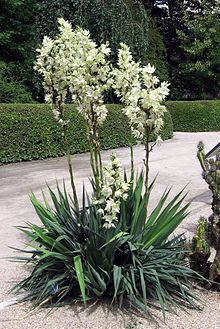Yucca flaccida
| Needle palm | |
|---|---|
 |
|
| Yucca flaccida, Royal Botanic Garden, Madrid | |
| Scientific classification | |
| Kingdom: | Plantae |
| Clade: | Angiosperms |
| Clade: | Monocots |
| Order: | Asparagales |
| Family: | Asparagaceae |
| Subfamily: | Agavoideae |
| Genus: | Yucca |
| Species: | Y. flaccida |
| Binomial name | |
|
Yucca flaccida Haw. |
|
| Synonyms | |
Yucca flaccida Haw., common names Adam's needle,weak-leaf yucca, or needle palm, is a species of flowering plant in the family Asparagaceae, native to south-central and southeastern North America from the lower Great Plains eastward to the Atlantic seaboard in Virginia, south through Florida and the Gulf states. Growing to 55 cm (22 in) tall by 150 cm (59 in) broad, it is a stemless evergreen shrub with a basal rosette of sharply pointed, swordlike leaves up to 55 cm (22 in) long. In summer, 150 cm (59 in) long panicles of bell-shaped creamy white flowers are held above the foliage.
The Latin specific epithet flaccida means "weak", "feeble", referring to the leaves which often fold under their own weight (the inner leaves may remain erect as they are supported by the outer ones).
Some authorities regard Y. flaccida as a variety or form of Y. filamentosa, rather than as a separate species. Both are cultivated and valued as architectural plants.
Numerous cultivars are available, some with variegated leaves, of which 'Golden Sword' and 'Ivory' have gained the Royal Horticultural Society's Award of Garden Merit.
...
Wikipedia
